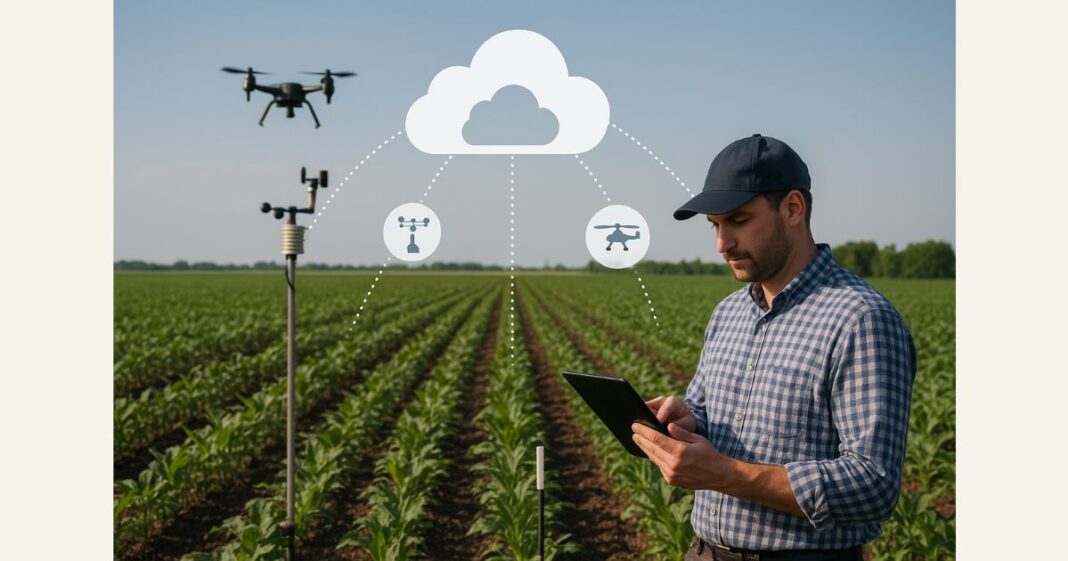The agricultural industry is experiencing a swift change with the incorporation of cutting-edge technologies like the Internet of Things (IoT) and cloud computing. This technological convergence has paved the way for the development of the Smart Agriculture System Using IoT, which enables real-time monitoring, efficient resource management, and data-driven decision-making. Among the various technologies used, cloud computing is crucial for the smooth functioning of these smart systems, as it offers scalable infrastructure, reliable data storage, and sophisticated analytical capabilities.
Table of Contents
Understanding IoT in Agriculture
The Internet of Things in agriculture describes a system of interconnected sensors, devices, and software applications that collect and share data regarding different facets of farming practices. This can involve soil moisture sensors, weather monitoring stations, GPS-equipped tractors, and drone surveillance systems. The primary goal is to automate agricultural processes and optimize resource use, thus improving crop yield, reducing operational costs, and minimizing environmental impact.
IoT devices generate massive volumes of data, including temperature, humidity, soil conditions, and crop health metrics. However, processing and analyzing this data in real-time requires substantial computational resources, which is where cloud computing becomes essential.
The Role of Cloud Computing in Smart Agriculture
Cloud computing is known for the computing services like storage, processing, networking, and analytics over the internet. It enables farmers and agricultural stakeholders to utilize the resources without the need for expensive on-site infrastructure.
Here are the key ways cloud computing supports IoT-based agricultural systems:
1. Data Storage and Management
IoT devices in agricultural environments continuously produce large quantities of structured and unstructured data. Cloud platforms offer virtually unlimited storage capacity, allowing users to store high-resolution images, sensor data, and machine logs without hardware constraints. Data stored in the cloud is centralized and can be accessed anytime, anywhere, facilitating real-time decision-making.
2. Real-Time Analytics
Timely decisions are critical in farming, especially when managing irrigation, fertilization, or pest control. Cloud computing enables real-time data analysis through advanced algorithms and artificial intelligence (AI) models hosted on the cloud. By processing sensor data instantly, farmers can receive actionable insights and alerts, such as when to irrigate or apply pesticides.
3. Scalability and Flexibility
Farming practices can range significantly in size, from small family-owned farms to expansive commercial operations. Cloud computing provides the adaptability to increase or decrease resources based on the needs and scale of the farm. In busy seasons, extra storage and processing capacity can be easily added and then reduced afterward, ensuring cost efficiency is maximized.
4. Remote Monitoring and Control
Using cloud platforms, farmers have the ability to oversee field conditions from a distance and manage automated systems like irrigation pumps, drones, and tractors. This is especially advantageous for expansive or isolated farms where manual observation requires significant time and labor. Cloud dashboards and mobile apps offer user-friendly interfaces for overseeing field activities from nearly any location.
5. Enhanced Collaboration
Cloud computing promotes collaboration among various stakeholders in the agriculture sector—farmers, agronomists, researchers, and government bodies. Shared data repositories and dashboards allow for collective data interpretation, improved transparency, and knowledge sharing. For instance, agronomists can access real-time field data and offer guidance without visiting the farm physically.
6. Security and Data Backup
Data security is a major concern in digital farming. Leading cloud service providers implement strong security protocols including encryption, authentication, and regular backups. This ensures that critical agricultural data is safe from cyber threats, hardware failures, or natural disasters. In case of data loss, cloud platforms allow quick recovery through automated backup systems.
7. Integration with Other Technologies
Cloud platforms serve as a bridge for integrating IoT with other cutting-edge technologies such as machine learning, blockchain, and big data analytics. For example, cloud-hosted AI models can analyze multispectral drone images to assess crop health, while blockchain solutions can be integrated for traceability in food supply chains.
Real-World Applications of Cloud-Based IoT Agriculture
Several real-world applications exemplify the synergy between cloud computing and IoT in agriculture:
- Precision Farming: Cloud-based systems collect data from IoT devices to determine optimal planting times, fertilization schedules, and irrigation plans.
- Weather Forecasting: Cloud platforms analyze local weather data to provide accurate forecasts and alerts, helping farmers prepare for adverse conditions.
- Livestock Monitoring: Wearable IoT sensors on animals can track health indicators and behavior patterns. The data is sent to the cloud for analysis and veterinarian intervention when anomalies are detected.
- Supply Chain Optimization: Cloud services support the end-to-end tracking of agricultural products from farm to market, improving efficiency and transparency.
Challenges and Considerations
Despite its benefits, integrating cloud computing in agriculture comes with challenges:
- Connectivity Issues: Numerous rural regions continue to experience unreliable internet connectivity, which is essential for real-time cloud services.
- Data Privacy: As sensitive information is kept in the cloud, it is crucial to adhere to data privacy regulations.
- Cost Implications: Although cloud computing reduces hardware costs, subscription and usage fees can be significant for small-scale farmers.
Future Prospects
As 5G networks expand and IoT device costs decline, the adoption of cloud-enabled smart farming solutions is expected to rise. The continued development of edge computing—which processes data closer to the source—may further complement cloud computing by reducing latency and bandwidth use.
Government initiatives and public-private partnerships can also play a crucial role in making cloud-based smart agriculture more accessible, especially in developing regions.
Conclusion
Cloud computing is undeniably a cornerstone technology in the advancement of IoT-based agriculture. It empowers farmers with the tools to make informed, data-driven decisions while promoting sustainability and efficiency. By addressing challenges such as connectivity and cost, and encouraging broader adoption, cloud computing will continue to transform traditional farming practices into a more intelligent, connected, and efficient Smart Agriculture System.



